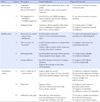1. Bell S. Will the kitchen table do?: Art therapy in the community. In : Pratt M, Wood MJ, editors. Art therapy in palliative care: The creative response. New York: Rutledge;1998. p. 38–49.
2. Chin YR, Lee IS, Chang HS. Analysis of the effects and nursing intervention of home health care in public health centers. J Korean Community Nurs. 2004; 15(3):353–363.
3. Chu SK, Yoo JH, Lee CY. The effects of a cognitive behavior program on cognition, depression, and activities of daily living in elderly with cognition impairment. J Korean Acad Nurs. 2007; 37(7):1049–1060.
4. Comijs HC, Jonker C, Beekman AT, Deeg DJ. The association between depressive symptoms and cognitive decline in community-doweling elderly persons. Int J Geriatr Psychiatry. 2001; 16(4):361–367.
5. Han YR, Song MS, Lim JY. The effects of a cognitive enhancement group training program for community-dwelling elders. J Korean Acad Nurs. 2010; 40(5):724–735.

6. Hopf GI. Group art therapy with schizophrenics in a drop-in center. Master Abstr Int. 1993; 32(6):1066.
7. Hwang RI, Lim JY, Lee YW. A comparison of the factors influencing the life satisfaction of the elderly according to their cognitive level. J Korean Acad Nurs. 2009; 39(5):622–631.
8. Jeong WM. The effects of group occupational therapy program for improvement of cognitive abilities in mild case of dementia. J Soc Occup Ther Aged Dement. 2007; 1(1):46–55.
9. Jhoo JH, Kim KW, Lee DY, Youn JC, Lee TJ, Choo IH, et al. Comparison of the performance in two different Korean versions of Mini-Mental State Examination: MM-SE-KC and K-MMSE. J Korean Neuropsychiatr Assoc. 2005; 44(1):98–104.
10. Ji HR, Choi SH, Cho MS, Ju RA. The effects of the continuous dementia nursing intervention program on cognitive function and depression of the elderly with mild dementia in the community. J Korean Gerontol Nurs. 2004; 6(2):216–227.
11. Kee BS. A preliminary study for the standardization of geriatric depression scale short form-Korea version. J Korean Neuropsychiatr Assoc. 1996; 35(2):298–307.
12. Kerr CC. The psychological significance of creativity in the elderly. Art Therapy: Journal of the American Art Therapy Association. 1999; 16(1):37–41.
13. Korean Society of Biological Nursing Sience. Mosby's medical, nursing & allied health dictionary. Seoul: Mosby & Hyunmoosa;2002.
14. Ko SG, Jung JH. Efficacy of a multifactorial memory enhancement program for older adults in the community. Korean J Clin Psychol. 2007; 26(3):545–572.
15. Lee DY, Lee KU, Jhoo JH, Youn JC. A normative study of the mini-mental state examination in the Korean elderly. J Korean Neuropsychiatr Assoc. 2002; 41(3):508–525.
18. Rebecca C, Magniant P. Art therapy with older adults. Springfield: Charles Thomas, Publisher, LTD;2004.
19. Riiey S, Malchlo C. Integrative approaches to family art therapy. Chicago: Magnelia Street Publishers;1994.
20. Sezaki S, Bloomgarden J. Home-based art therapy for older adults. J Am Art Ther Assoc. 2000; 17(2):283–290.

21. Sherman JE. Group art therapy interventions with adults in psychiatric setting. Master Abstr Int. 1996; 34(8):1684.
22. Shin KR, Byeon YS, Kang YH, Oka J. A study on physical symptom, activity of daily living, and health-related quality of life (HRQoL) in the community dwelling older adults. J Korean Acad Nurs. 2008; 38(3):437–444.
23. Yesavage JA, Brink TL, Rose TL, Lum O, Huang V, Adey MB, et al. Development and validation of geriatric depression screening scale: A preliminary report. J Psychiatr Res. 1982-1983; 17(1):37–49.




 PDF
PDF ePub
ePub Citation
Citation Print
Print






 XML Download
XML Download